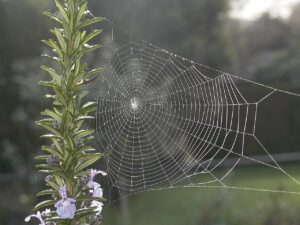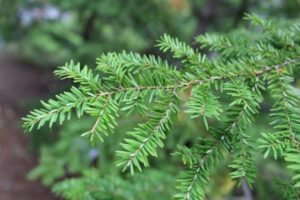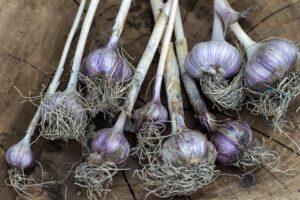
We are definitely into fall season with some frosts already gracing our gardens in some locations and taking out the tender annuals like basil or impatiens. Underneath the soil though we are seeing a little different story. Our long spell of dry weather beginning with the heat in early June (record breaking) and continuing with a very hot July and a very dry August and September with warm temps have left their legacy on our gardens. Though we had some slight measurable precipitation (drizzle) mid to late July and a big rainstorm in August and in October so far we have had some rain it has not been enough to recharge our soil. When pulling out the last of the ‘Zephyr’ squash and transitioning the raised garden bed for a try at some quick growing radishes and arugula we discovered the soil a few inches down was still dry. If you are in the process of removing summer annuals and planting new things for your garden, whether annual or perennial, be sure to water them in well. Keeping your new plantings hydrated will ensure their success as they build new roots and continue to photosynthesize, especially for evergreen plants. Water keeps plant cells functioning properly, allows photosynthetic functions to occur, is crucial for nutrient transport and building of new cells, and keeps plants structurally sound. Keep checking the weather reports and be pro-active in keeping your plants, new and old, well hydrated this time of year. They will thank you for it in more robust growth next spring.
Fall is Planting Season
This is a great time of year to plant; soil temperatures are cooler but still warm enough for plants to establish a good root system. Air temperatures are also cooler and reduce the stress on plants as they slow leaf growth or go dormant. Seasonal rain this time of year do your watering work for you. It’s a great time to plant just about anything except frost tender plants but especially a fun time to focus on a few really special types of plants for your garden.
What Should You Plant?
- Evergreens
- Bulbs
- Plants with Fall Color or Attractive Winter Bark
- Plants that Feed Wildlife
- Plants with Winter Blooms
There are many places to find ideas for new plants for your garden – in person, online, or in books. Here is a short list of some of our favorite fall and winter plants and where to find more information. Remember to improve the soil as you plant by enhancing the entire garden bed you are planting into rather than just the planting hole. This enables the roots to spread out into the bed.
The Garden Hotline Top 5 Favorites for Fall Gardens

- Rosemary – Rosmarinus sp. – The bloom season starts sporadically in the fall for the fragrant, evergreen rosemary shrub, offering food for hummingbirds in an otherwise less floriferous season over the winter. By May they will be in full bloom. Some varieties have twisty stems and others arrow straight ones you can use for summer shish kabobs next season. Best in full sun.

- Canadian Hemlock. – Tsuga canadensis – Canadian Hemlock is a good alternative to Arborvitae as a screen plant. With its feathery soft foliage this evergreen conifer adds texture to complement native plants and other ornamentals. Evergreen conifers provide wonderful nesting and shelter habitat for northwest wildlife and offer other environmental services like breaking up windy gusts and shading the garden in the hot sun. Tolerates sun or shade.

- Ginkgo – Ginkgo biloba – This powerhouse of a tree is a conifer / cycad relative, one of a kind in its plant classification, is a “living fossil” and has been on the planet for some 200 million years, and is tolerant of air pollution as well. As if that is not enough the brilliant yellow uniquely fan shaped leaves are a wonder in the fall. Ginkgo is dioecious, sporting pollen on one plant and fruit on the other. Beware though as the fruit of the Ginkgo plant is pretty potently odiferous!

- Beautyberry – Callicarpa sp. – C. americana is a native, deciduous shrub in the southeastern US and there are also lovely cultivars from Asia worth considering. They all provide a late show of incredibly gloriously iridescent magenta purple berries along the stems. The fruit persists until the foliage drops in the fall and the birds will add to the colorful display with their visits to forage through the colored leaves and bright berries.

- Garlic – Allium sativum – On the vegetable garden front consider planting garlic in the fall with the goal of a June or July harvest next year. Garlic comes in many colors and can have soft necked stems that are suitable for braiding together or hard neck varieties that produce delectable edible “scapes” as they bloom. Harvest the flower scapes to eat and allow the garlic to keep building its bulb for later harvest. Many of the more colorful varieties are not easy to find in grocery stores so try growing them for yourself. Take a bulb of garlic and break the cloves apart to plant individually. Each clove will develop into a full bulb next summer for harvest.
These plant choices are available at local nurseries and garden centers and at online vendors. Call us for help locating them!
In Person Viewing
- Local Garden Centers and Nurseries – remember when you are seeing something in a pot that it is not what it will look like as a mature plant. Be sure to check mature sizes – plant tags give you ten year size estimates. Sometimes things get bigger over time!
- Local Nursery Locator
- Puget Sound Public Gardens
- Take a walk in your own neighborhood – you can see plants in a setting that would be similar to your own. Get to know your neighbors!
Online Sources
- Great Plant Picks
- Washington Native Plant Society
- King County Native Plant Guide
- Plants for Salmon Friendly Gardens
- Bulb Company Catalogs – there are many different companies to investigate
Books
- Right Plant, Right Place; Nicola Ferguson
- Gardening With Native Plants of the Pacific Northwest; Arthur R. Kruckeberg
- Trees and Shrubs of the Pacific Northwest; Turner and Kuhlman
Call or email us to learn more about fall planting and plant choices.
206-633-0224